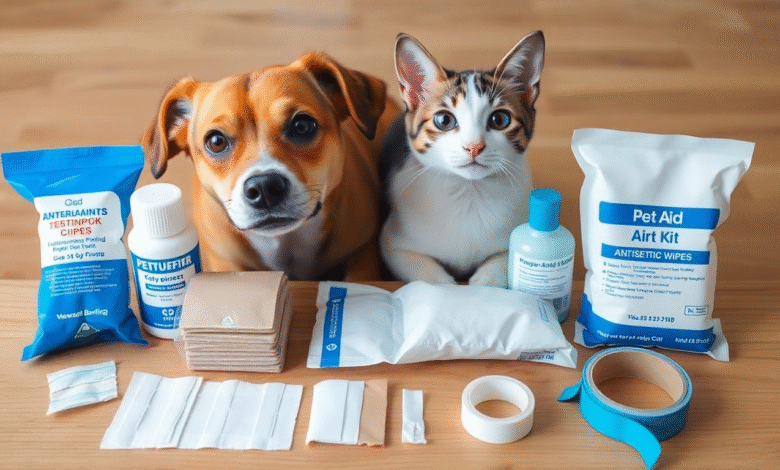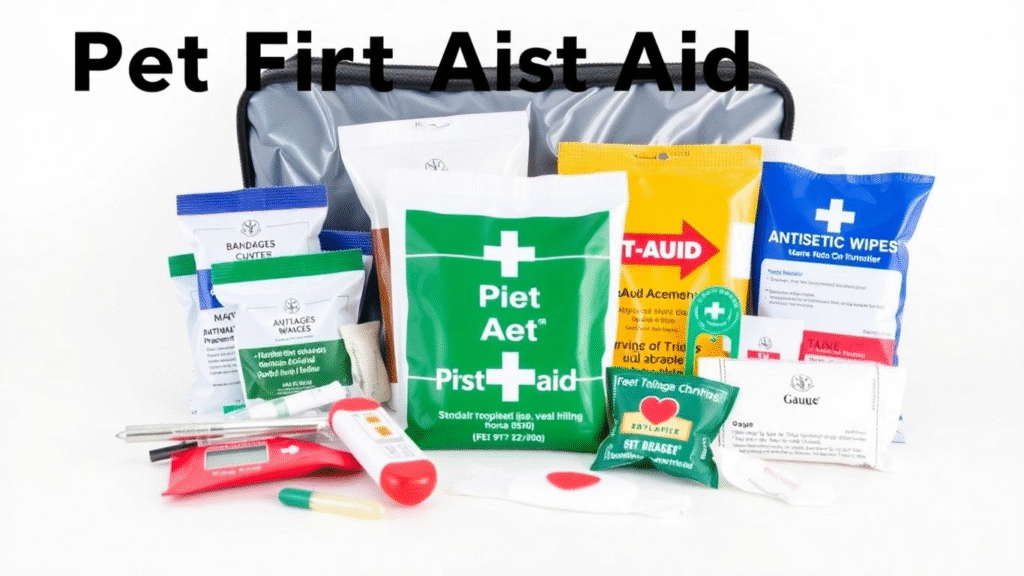How to Build a Pet First Aid Kit Every Owner Should Have at Home

Why Every Pet Owner Needs A First Aid Kit
Accidents happen. It doesn’t matter if your pet is a couch potato or an adventure buddy; they can get hurt. A pet first aid kit is not just a good idea; it’s a necessary part of being a responsible pet owner. When your furry friend is in distress, every second counts. Having the right supplies ready can make a big difference in managing the situation until you can get to the vet. According to Busy Pet Parent, focusing on pet health and safety ensures that owners are always prepared for emergencies, helping to protect their pets from preventable harm and stress.
Think of your pet first aid kit as a bridge. It helps you provide immediate care and stabilize your pet when an unexpected injury or illness strikes. This preparation can prevent minor issues from becoming major emergencies. It’s about being ready to act calmly and effectively when your pet needs you most.
A well-stocked kit is your first line of defense. It allows you to address immediate needs, reduce pain, and prevent further harm. This proactive approach is key to maintaining your pet’s health and safety, giving you peace of mind.
Bridging The Gap Until Veterinary Care Is Available
When your pet experiences an emergency, the time it takes to reach a veterinarian can feel like an eternity. This is where your pet first aid kit becomes invaluable. It provides the tools and materials needed to offer immediate assistance, helping to stabilize your pet and prevent their condition from worsening.
For instance, a deep cut might need to be bandaged to control bleeding, or a mild allergic reaction might require an antihistamine. These immediate actions, taken with the supplies from your kit, can significantly improve your pet’s outcome. They buy you precious time and can make a critical difference.
The goal of a pet first aid kit is not to replace professional veterinary care, but to provide temporary relief and stabilization until that care can be administered. It empowers owners to act decisively in critical moments.
Tailoring Supplies To Your Pet’s Physiology
Every pet is unique, and their needs can vary greatly. What works for a large dog might not be suitable for a small cat, and vice versa. It’s important to consider your pet’s specific physiology when assembling your first aid kit. This means thinking about their size, breed, age, and any pre-existing health conditions.
For example, medication dosages need to be adjusted based on weight. Items like muzzles or bandages should be sized appropriately. A kit for a cat might include different wound care items than one for a dog, depending on their typical injuries. Tailoring your kit ensures you have the right tools for your pet.
Here are a few considerations:
- Size Matters: Ensure bandages, muzzles, and carriers are appropriately sized for your pet.
- Species Specifics: Some medications or treatments are safe for dogs but toxic to cats, and vice versa.
- Health Conditions: If your pet has allergies or chronic illnesses, include specific items recommended by your vet.
Essential Supplies For Your Pet First Aid Kit

When accidents happen, having the right supplies readily available can make a significant difference. A well-stocked pet first aid kit is not just about bandages; it’s about having the tools to manage a situation until professional veterinary help can be reached. This section covers the core items that form the backbone of any good pet first aid kit, focusing on wound care, vital signs, and cleaning.
Wound Care Essentials: Gauze, Pads, And Wraps
Dealing with injuries often means managing bleeding and protecting wounds. Having sterile gauze pads and rolls is key. These can be used to apply direct pressure to stop bleeding or to cover a wound after it’s been cleaned. Non-stick pads are particularly useful as they won’t adhere to the wound bed, making bandage changes less painful and damaging. For securing dressings, self-cling bandages, often called vet wrap, are ideal. Unlike adhesive tape, they stick to themselves, not to fur, and provide firm but flexible support without cutting off circulation. Proper bandaging is critical for preventing infection and further injury.
Vital Signs Monitoring: Digital Thermometer And Lubricant
Knowing your pet’s normal temperature is important, and a digital thermometer is a straightforward way to check. It’s best to use a rectal thermometer specifically for pets, and always have a water-based lubricant on hand to make insertion easier and more comfortable for your animal. A normal temperature for dogs and cats typically ranges from 100.5 to 102.5 degrees Fahrenheit. Being able to accurately take your pet’s temperature can provide vital information to your veterinarian, especially if they are showing signs of illness or distress. This simple tool can be a lifesaver.
Cleaning And Disinfection: Saline Solution And Wipes
Keeping wounds clean is paramount to preventing infection. Sterile saline solution is excellent for flushing out debris from wounds or eyes. It’s gentle and effective. Antiseptic wipes, specifically designed for pets, can also be useful for cleaning minor scrapes or around wounds. Always use these products as directed, and remember that while cleaning is important, it’s a step in first aid, not a replacement for veterinary care. A clean environment for treating your pet is always best.
A pet first aid kit is a collection of items, but its true value lies in the owner’s preparedness to use them effectively. Regular checks and restocking are as important as the initial assembly.
Medications And Treatments For Emergencies
When your pet faces an unexpected health issue, having the right medications and treatments ready can be a lifesaver. These items bridge the gap until you can reach a veterinarian, providing immediate relief and stabilization. It’s important to remember that these are for emergency use and should always be followed by professional veterinary care. Always consult your vet before administering any medication to your pet, as dosages and suitability vary greatly by species, breed, and individual health.
Antihistamines For Allergic Reactions
Allergic reactions in pets can range from mild itching to severe swelling. An antihistamine like diphenhydramine (commonly known as Benadryl) can help manage these symptoms. It’s crucial to use only the plain form of diphenhydramine, without any added decongestants or other medications, as these can be harmful to pets. Always confirm the correct dosage with your veterinarian, as an incorrect amount can be ineffective or even toxic. Keep a small chart with the vet-approved dosage for your pet’s weight readily available in your kit.
Antibiotic Ointments For Minor Infections
Small cuts, scrapes, or abrasions can sometimes become infected. A pet-safe antibiotic ointment can help prevent bacterial growth and promote healing for minor wounds. Apply it gently to the affected area after cleaning the wound thoroughly. This is a good addition for those inevitable little injuries that happen during play or exploration. Remember, for deeper wounds or signs of significant infection, veterinary attention is necessary.
Hydrogen Peroxide For Inducing Vomiting (With Caution)
In cases of suspected poisoning, your veterinarian or a poison control center might advise you to induce vomiting. A small amount of 3% hydrogen peroxide can be used for this purpose, but only under direct veterinary guidance. It’s critical to use the correct concentration and dosage, as improper use can cause serious harm. Never induce vomiting if your pet is unconscious, having trouble breathing, or has ingested something caustic. Always have the poison control hotline number handy for immediate advice.
Information And Contact Details
When an emergency strikes, quick access to the right information is just as vital as having the right supplies. Your pet first aid kit should be a hub of critical contact details and health records, ensuring you can get help fast, even if you’re flustered.
Emergency Contact Card and Health Records
Having a dedicated card or section within your kit for your pet’s information is a smart move. This isn’t just about your vet’s number; it’s about having a snapshot of your pet’s health readily available. This information can be a lifesaver when you’re not the one administering aid.
- Your pet’s name and a recent photo.
- Any known allergies (medications, food, environmental).
- Chronic health conditions and current medications.
- Vaccination status and dates.
Veterinarian and Emergency Clinic Information
Beyond your regular vet, knowing where to go when they’re closed is key. Keep the details for the nearest 24-hour emergency veterinary clinic handy. This includes their address and phone number. It’s also a good idea to note down any specialty clinics if your pet has specific health needs.
It’s wise to have this information printed out, not just stored on your phone. What if your phone battery dies or you lose service? A physical copy of your pet’s information is a reliable backup.
Poison Control Center Hotlines
Accidental ingestion of toxins is a common pet emergency. Having the direct number for a pet poison control center is non-negotiable. These centers are staffed by experts who can provide immediate guidance on what to do, and whether you need to get to a vet right away. They can often tell you if a substance is toxic to pets and what the next steps should be.
Remember, time is often of the essence in poisoning cases. Having these numbers readily accessible can make a significant difference in the outcome for your pet.
Tools For Assessment And Administration
When your pet has an accident, having the right tools can make a big difference. These items help you figure out what’s going on and how to give any needed treatment. They are key parts of your pet first aid kit.
Tweezers and Scissors for Debris Removal
Little bits of stuff can get stuck in your pet’s fur or skin. Fine-tipped tweezers are great for pulling out splinters or other small objects. Make sure they have a good grip. Scissors with blunt ends are important for carefully cutting away matted fur or bandages without accidentally poking your pet. These tools help you clean up wounds before you treat them.
Having the right tweezers and scissors means you can safely remove foreign objects without causing more harm.
Gloves for Protection
It’s really important to wear gloves when you’re helping an injured pet. This protects you from any germs or fluids your pet might have. It also keeps the wound clean from your hands. Disposable gloves are easy to use and discard. Always have a few pairs handy in your kit. This simple step is a big part of safe pet first aid.
Oral Syringe or Turkey Baster for Medication
Giving medicine to pets can be tricky. An oral syringe or a turkey baster with a rubber tip is perfect for this. You can accurately measure liquid medicine and give it to your pet directly in their mouth. This is much better than trying to force a pill down their throat, which can be stressful for both of you. These tools make administering medication much simpler and safer.
- Tweezers: For removing splinters, thorns, or ticks.
- Blunt-tip Scissors: For cutting bandages or fur around a wound.
- Disposable Gloves: To maintain hygiene and prevent infection.
- Oral Syringe/Turkey Baster: For administering liquid medications accurately.
Maintaining Your Pet First Aid Kit
Regularly Review And Restock Supplies
Think of your pet first aid kit like a pantry. You wouldn’t want to reach for an ingredient only to find it’s empty or expired, right? The same goes for your pet’s emergency supplies. Regularly checking and restocking is key to having a functional pet first aid kit when you actually need it. It’s not a ‘set it and forget it’ kind of thing.
Make it a habit to pull out your kit every few months. Go through each item. Did you use the gauze during that unfortunate incident with the rose bush? Is the saline solution still sealed? Replacing used items and anything that’s gone missing is the first step in maintaining your pet first aid kit. This proactive approach means you’re always ready.
Check Expiration Dates And Replace Items
This is super important. Medications, especially, have a shelf life. An expired antibiotic ointment isn’t going to do much good for a minor infection. Same goes for sterile pads – if the seal is broken or the date has passed, they’re no longer sterile. It’s a simple step, but checking expiration dates on everything in your pet first aid kit can make a big difference.
Keep a small notepad or a note on your phone to jot down items that are nearing their expiration. This way, you can pick them up on your next shopping trip. Don’t wait until you desperately need something to discover it’s no longer good. Proper maintenance means checking those dates.
Store Your Kit Safely And Accessibly
Where you keep your pet first aid kit matters. It needs to be somewhere you can get to it quickly in an emergency, but also somewhere your pet (or curious kids) can’t get into it. A high shelf in a closet or a sturdy bin with a secure lid usually works well. If you have one kit for home and one for the car, make sure both locations are known to all responsible adults in the household.
A well-maintained pet first aid kit is a testament to responsible pet ownership. It shows you’re prepared for the unexpected and prioritize your pet’s well-being.
Consider labeling the container clearly, maybe with a big red cross or the words ‘PET FIRST AID’. This makes it easy to spot in a stressful situation. Having a designated, safe, and accessible spot for your pet first aid kit is the final piece of the puzzle for keeping it ready for action.
Beyond Supplies: Essential Pet Health Skills
Basic Pet CPR and First Aid Knowledge
Having the right gear in your pet first aid kit is one thing, but knowing how to use it is another. Learning basic pet CPR and first aid techniques can make a huge difference in an emergency. Think of it like this: the kit is your toolbox, but the skills are how you actually build something with it. There are many courses available, some even taught by vets, that can walk you through common emergencies. These courses cover things like how to properly bandage a wound, what to do if your pet is choking, or how to recognize signs of heatstroke. Knowing these skills means you can act confidently when your pet needs you most.
Understanding When to Seek Veterinary Care
It’s super important to know the limits of what you can do with a pet first aid kit. While it’s great for immediate care, it’s not a replacement for professional veterinary help. You need to be able to tell when a situation is beyond basic first aid and requires a vet’s attention right away. Things like deep wounds, suspected broken bones, severe bleeding, or signs of serious illness definitely mean a trip to the clinic. Your pet first aid kit is for bridging the gap until you can get professional help, not for treating serious conditions on your own.
Practicing With Your Kit and Its Contents
Just like any skill, using your pet first aid kit gets easier with practice. Don’t wait for an emergency to figure out where everything is. Take some time every few months to open up your kit. Check expiration dates on medications and ointments. Make sure sterile items are still sealed. Practice wrapping a bandage on a stuffed animal or even on yourself to get a feel for it. This familiarization helps reduce panic if you ever need to use the kit for real. Regularly reviewing and restocking your kit ensures it’s always ready.
Final Thoughts
Putting together a pet first aid kit might seem like a lot, but it’s really about being ready for the unexpected. Accidents happen, and having the right supplies and knowing how to use them can make a big difference when your pet needs help. It’s not about replacing vet visits, but about being able to handle small issues or stabilize your pet until you can get professional care. So, take the time to build your kit, learn the basics, and keep it somewhere accessible. Your pet relies on you, and being prepared is a simple, yet powerful, way to show you care.




